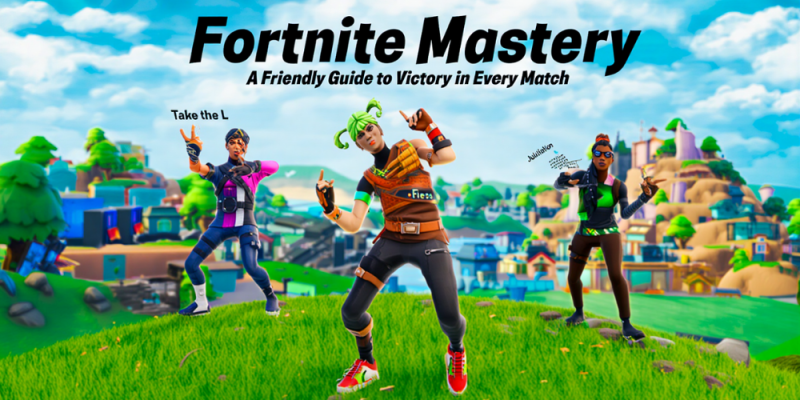Fortnite Mastery: A Friendly Guide to Victory in Every Match
- Landon White
- October 06, 2025

Fortnite is fast, colorful, and full of surprises. Whether you are new or returning after a break, this guide will help you win more. We focus on clear steps you can use in your very next match. You will learn how to set up your controls, choose smart landing spots, fight better, and make good decisions in Build and Zero Build modes.
Fortnite changes every season, but the core skills stay the same: awareness, movement, aim, and smart rotations. Read on for practical tips, simple examples, and small habits that add up to big results.
Getting Started
Settings and Controls
Good settings make the game easier right away. Start with sensitivity that lets you track targets without over-aiming. If you are on controller, lower your look sensitivity a bit and turn on aim assist. On mouse and keyboard, try a medium-low sensitivity (for example, 400–800 DPI and 6–8% in-game) and adjust after a few matches.
Turn on “Visualize Sound Effects” in audio settings. This lets you see footsteps, gliders, and shots on your screen, which helps you react faster. Reduce motion blur and use performance mode (if available) to keep stable FPS. Choose a keybind layout you can reach without stretching your fingers. Keep common actions on easy keys: build, crouch, jump, reload, and weapon slots.
Choose Your Mode
Pick the mode that fits your style. Zero Build rewards positioning, aim, and smart use of cover. Build mode rewards editing and fast structures. Team Rumble is great for warm-up because you respawn. Creative maps and aim trainers are perfect for practice. Start with the mode you enjoy most, then explore others.
Early Game: Landing and First Loot
The match often depends on your first 60 seconds. Choose a landing spot with enough loot, but not too busy. Hot drops (high-tier named POIs) are fun but risky. Safer drops (edges of the map or small landmarks) let you gear up and learn the game flow without constant third parties.
As you glide, watch other players. If a roof is contested, switch to a nearby chest or ground gun. Land on a weapon, then grab shields. Open chests quickly and keep moving. If you hear enemies close, fight fast or rotate away before more arrive.
- Always land on a gun before a chest.
- Pop small shields (minis) first, then big shields.
- Use cover early—rocks, walls, or natural terrain.
- If you win the first fight, reload, heal, and gather mats (in Build mode).
Mid Game: Rotations and Awareness
After early fights, your goal is to reach the next safe zone with good resources. Avoid running in the open. Move from cover to cover, use natural height, and plan your path so you do not cross the whole map under fire. If the storm is far, start moving early and loot as you go. Use cars or mobility items when safe, but do not drive straight into a fight.
Third-party fights (engaging two teams already fighting) is an easy way to get eliminations. Listen for gunshots and close in from the side or high ground. Wait for a knock or heavy damage, then push fast. Do not tunnel vision—other players may third-party you in return.
- Rotate on the safe side of the zone, not through the middle if you can avoid it.
- Keep scan tools or recon items if the season has them.
- Heal up before crossing open spaces.
- Plan exits before you enter a big fight.
Combat Fundamentals
Fortnite gunplay rewards accuracy and smart timing. Use an assault rifle or DMR for medium range, a shotgun for close range, and an SMG or pistol to finish. Peek from the right side of cover and crouch to reduce your exposed body. Do not spam shots; time your bursts to control recoil and hit more shots.
Crosshair placement saves lives. Keep your crosshair at head or upper chest height when you move. Pre-aim common angles before you see an enemy. When you reload, step behind cover or build a wall. In close range, strafe side to side and jump sparingly to throw off aim without losing your own accuracy.
- Open with a long-range tag to weaken enemies, then push.
- In close fights, swap weapons instead of reloading mid-fight.
- Use audio and visual cues to predict peaks and edits.
- Heal only when safe—behind cover or after you place walls.
Build vs Zero Build
In Build mode, think of structures as instant cover and angles. A quick wall blocks shots; a ramp gives height; a cone stops people from jumping into your box. Basic edits (door, window, corner) create surprise angles. Do not overbuild—keep it simple: wall-ramp, box up to heal, and ramp-peek to take shots.
In Zero Build, your “builds” are terrain, rocks, trees, and vehicles. Movement tools and map knowledge are key: rotate along ridges, use zip lines wisely, and take high ground before others. Cover is your best friend. Trade damage only when you have a safe retreat or a guaranteed finish.
Loadouts and Items
A balanced loadout helps you handle any situation. Aim for one long- to mid-range weapon (AR/DMR), one close-range (shotgun), one utility slot (SMG or pistol), and two slots for heals or mobility. If you are confident with aim, you can drop the SMG and carry extra heals or movement.
Heals keep you in the fight. Carry fast heals (minis, splashes) and one big heal (big pot or medkits if useful in the season). Choose mobility based on what is available this season—grapples, shockwaves, gliders, or vehicles. Seasonal perks and items change, so adapt: if a mechanic gives you mobility, you can carry more heals or an extra weapon.
- Color rarity matters, but positioning and aim matter more.
- Upgrade a favorite weapon when you can do it safely.
- Swap out duplicate roles (do not carry two similar ARs).
- Keep at least one quick-heal item for emergencies.
Movement and Positioning
Good movement wins fights before they start. Stay on high ground when possible. Avoid running in the open; zig-zag between cover and use crouch to hide your footsteps when close. If you get tagged hard, do not ego-challenge—retreat, heal, then re-engage from a better angle.
- Slide and mantle to move faster and surprise enemies.
- Use natural shadows and bushes to break line of sight.
- Do not stay in the same window or angle after firing.
- Rotate early to claim strong positions in the next zone.
Endgame Strategy
Endgame is about control and patience. The zone is small, and many players are stacked. In Build mode, keep your builds clean and connected. Conserve materials by moving along existing structures. Take short, safe peeks for tags. Only drop on low ground if you must; height wins many games.
In Zero Build, pick a safe power position before the zone closes. Rocks, rooftops, and ridges are strong. Third-party carefully—do not overexpose. If you are in the open, smoke, shields, or mobility (if available) can save you. Play the edge, then slide into the next cover when the zone moves.
- Track how many players are left and where shots are coming from.
- Save mobility for the last two zones if possible.
- In final circles, value cover and angles over risky finishes.
- Heal-off wins are rare but possible—carry heals if the lobby is stacked.
Duo and Squad Play
Teamwork multiplies your power. Call out enemy positions, damage numbers, and your plans before you push. Focus fire the same target to finish downs quickly. Revive safely—throw a knock behind cover first if you can.
- Share ammo, heals, and mobility so everyone is ready.
- Play roles: entry fragger, support, IGL (shot-caller).
- Double-peek from different angles to split enemy attention.
- In Build mode, chain builds to move as a unit and avoid splits.
Common Mistakes to Avoid
- Hot dropping every game without a plan. Mix safe drops for consistency.
- Standing still while shooting. Always strafe or peek from cover.
- Chasing one elim into a third party. Secure the area first.
- Overbuilding and losing track of the enemy. Build with purpose.
- Holding extra weapons instead of heals or mobility.
- Reloading in the open. Reposition or place cover first.
- Ignoring audio cues. Use “Visualize Sound Effects” to track threats.
A Simple Practice Plan
- 5 minutes: settings check and warm-up aim (Creative aim maps or range).
- 10 minutes: shotgun + SMG swap practice and close-range duels.
- 10 minutes: building basics (wall-ramp, box, simple edits) or Zero Build movement drills (cover-to-cover paths).
- 3 matches: focus on a single goal each game (safe landing, clean rotations, or endgame positioning).
- After matches: review one mistake and one success. Adjust your plan.
Conclusion
Fortnite rewards small, smart habits. With good settings, safe early game choices, clean rotations, and calm endgame decisions, you will win more often. Keep your loadout simple, your movement smart, and your comms clear in team modes.
Final tips to remember:
- Land on a weapon, then shields, then rotate early.
- Use cover or builds for every peek and reload.
- Carry balanced items: range, close combat, heals, mobility.
- Take third-party opportunities, but leave before you get third-partied.
- Practice a little every day—consistency beats long, rare sessions.
Jump in, try these steps, and tweak them to fit your style. See you in the Victory Royale screen!















